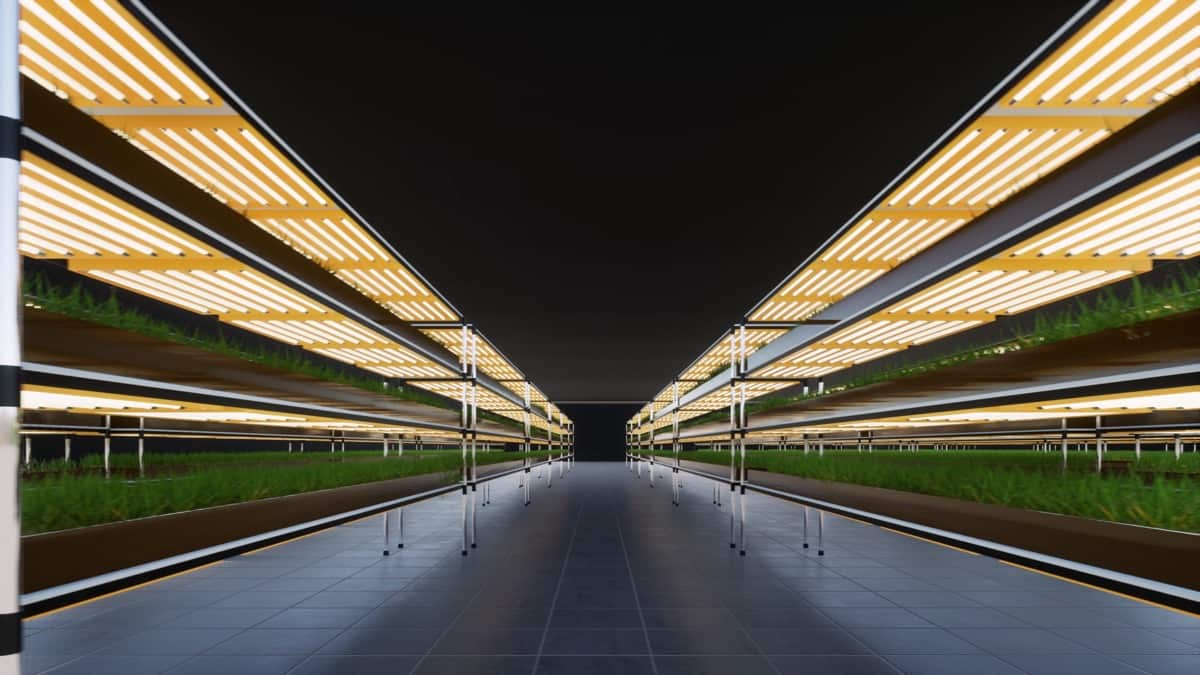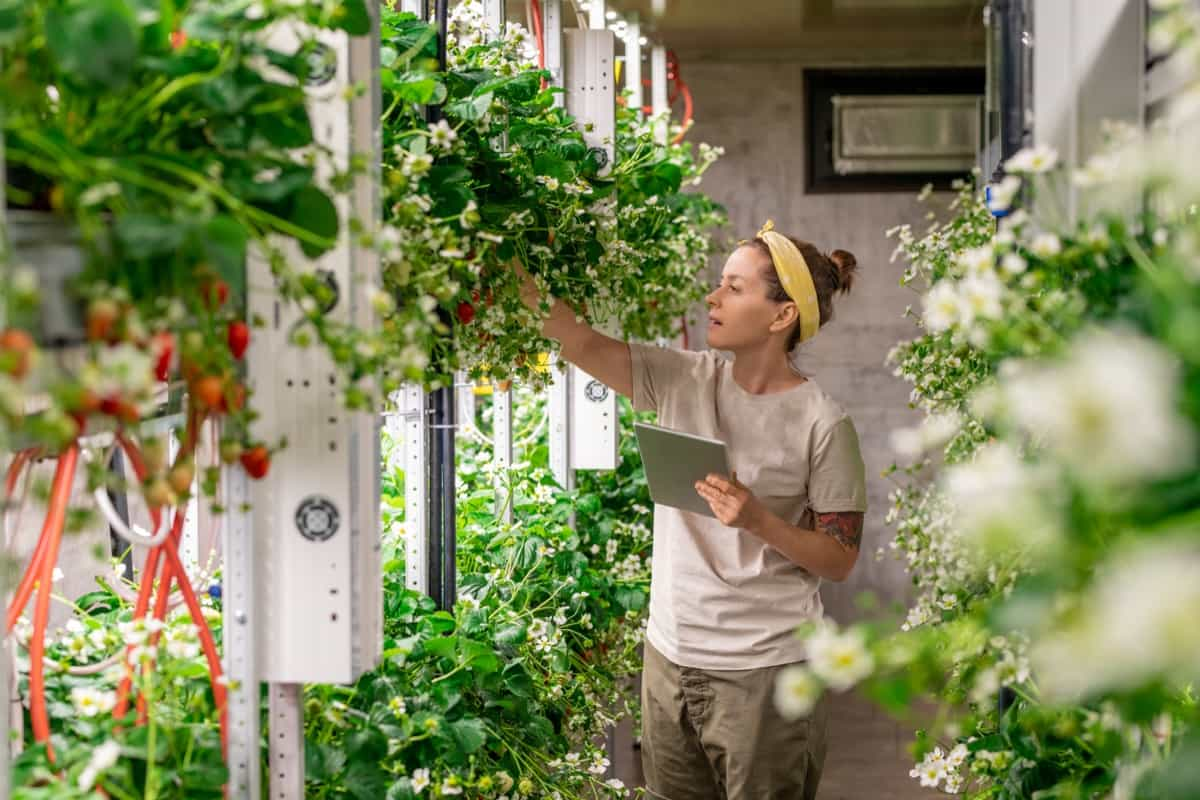A method of growing plants without soil is called Aeroponics. It is instead irrigated with a nutrient-dense mist that suspends roots in the air. On the other hand, hydroponic systems submerge plant roots regularly in nutrient-rich solutions. A typical aeroponics system suspends the plant in an atmosphere that is either fully or partially closed. The procedure should be carried out in a controlled, closed environment to control the amount of light, air, and nutrient-rich water spray delivered to the plant.

A vertical farming technique using Aeroponics involves layering crops vertically. Growing is done in a controlled environment using soilless methods such as aquaponics, hydroponics, and Aeroponics. This system works best when a proper temperature is maintained, and the necessary amount of nutrient-rich mist is available. Due to a growing population and a lack of farmland, vertical farming may be an effective way to meet the world’s growing food demand.
Aeroponic Vertical Farming
Types of Aeroponic Systems
Low-pressure Aeroponics (LPA)
This type of aeroponic system is popular among hydroponic hobbyists because it is simple to set up, readily available, and inexpensive. Droplets in a low-pressure aeroponic system are much smaller than those in a high-pressure aeroponic system. The sprinkler heads of this hydroponic system spray water around the roots of the plants like any hydroponic system.
High-pressure Aeroponics (HPA)
Due to the specialized equipment required, this type of Aeroponics is more advanced and more costly to set up. As a result, they are more commonly used in commercial production than by home growers. HPAs must run at high pressures to atomize water into tiny droplets no larger than 50 microns. Due to its fine droplet size, this system creates more oxygen for the root zone than the LPA, making it the most efficient aeroponic system.
Ultrasonic fogger Aeroponics
Ultrasonic fogger Aeroponics, commonly called fogponics, is another interesting type of Aeroponic system. As the name means, growers would use an ultrasonic fogger to atomize water into super small water droplets. These are very tiny, and you will see them in fog. Though plant roots find it easier to absorb water in tiny sizes, there’s little moisture in the fog created, and when running over time, it can easier create salt that can clog these foggers than other Aeroponic types.
What Can You Grow with Aeroponics?
Aeroponics systems have many applications, including growing leafy greens, culinary herbs, cannabis, strawberries, tomatoes, and cucumbers. Aeroponics is best suited to root crops, impractical in hydroponic systems. It is easy to harvest the roots since they have plenty of room to grow.
Vegetable crops with more complex nutrient requirements are also possible. The size of fruiting shrubs and trees makes them impractical for aeroponics systems. The most advanced infrastructure allows you to cultivate root and tuber crops even though they are less common in this system. The cost of doing so, however, can be high.
In case you missed it: How to Start Vertical Hydroponic Farming at Home: Step-By-Step Guide for Beginners

Fertilization for the Plants Growing in Aeroponics
Aeroponics involves suspending plant roots in the air and irrigating them with nutrient-dense mist. It mimics the natural air pockets in a healthy soil system and increases oxygen and other atmospheric gases available to plants. Across various crops, this can boost the plant’s root health and growth rate.
Aeroponics also uses far less water – up to 30% less than hydroponics and 95% less than outdoor farming – due to less evaporation of growing media mounted within the system, requiring less water overall. The system also doesn’t require Rockwool, the fibrous insulation many systems use, which is hard to handle safely, reuse and recycle.
Irrigation in Aeroponics Systems
Controlling irrigation on a crop-by-crop basis with an aeroponic system is possible. The mist can be applied to crops in very precise amounts and for specific periods, unlike flooding them with water, giving greater control than a hydroponic system. By using Aeroponics, you can tailor the water, nutrient levels, and gas exchange provided to crops based on their individual requirements and adjust according to their growth stage.
Advantages of Aeroponics
- Productive and Sustainable: Water is used 80-90% less in this renewable method of food production than in soil-based farming. In this field, you can grow much food, healthier varieties, and more profitably because you can use height and air as a growing environment.
- Exposure to air promotes healthy and rapid growth of plants: Since Aeroponics involves growing plants using tiny drops of water in the air, it can be used to grow plants of virtually any species rapidly. Thus, soil-based farming can grow more plants faster than soil-based farming.
- It Can Be Cultivated without Land: It is possible to grow your food right now if you have a small garden or roof space. You do not have to cultivate a vast area. In your living room or balcony, you can build small aeroponics units to experience the beauty of Aeroponics and meet your daily food requirements.
- Photosynthesis is Promoted via Aeroponics: Besides being environmentally friendly, it is also energy efficient. Aeroponics promotes plant oxygen production by removing significant carbon dioxide from the environment.
Disadvantages of Aeroponics
- Aside from the associated costs, proper expertise, and training are needed to succeed. To use Aeroponics, one must be thoroughly trained in keeping the system clean. As it is a scientific system supported by technology that is still developing, the caretaker must always upgrade their abilities.
- The tangible elements are difficult to sustain. This system has many components, some of which could fail if not properly maintained.
- In the closed or indoor method of aeroponics farming, maintaining the proper supply of light and air for the exposed part of the plant can sometimes be challenging, especially when vertical farming in the air is the way to maximize production. Artificial lighting becomes crucial in this situation.
In case you missed it: Vertical Farming Technology: A-Step-By-Step Guide

Conclusion
Aeroponics is one of the major farming methods in the inward system. This farming system is becoming popular due to its ability to maintain the growing environment and yield greater yields. It is that method where plants grow without soil and aquaponics or hydroponics farming techniques.
- Feed Your Flock for Less: Top 10 Tips to Save on Chicken Feed
- Ultimate Guide to Ossabaw Island Hog: Breeding, Raising, Diet, and Care
- Hatching Answers: The Top 10 Reasons Your Chickens Aren’t Laying Eggs
- Eggs and Economics: Breaking Down the Cost of Raising Backyard Chickens
- Defend Your Greens: Proven Methods to Keep Iguanas Out of Your Garden
- Ultimate Guide to Cinnamon Queen Chicken: A Comprehensive Guide for Beginners
- Ultimate Guide to California Tan Chicken: Breeding, Raising, Diet, Egg-Production and Care
- Ultimate Guide to Marsh Daisy Chicken: Breeding, Raising, Diet, and Care
- 10 Types of Chicken Farming Businesses You Can Start for Profits